AEROSPACE Hypersonic passenger flight
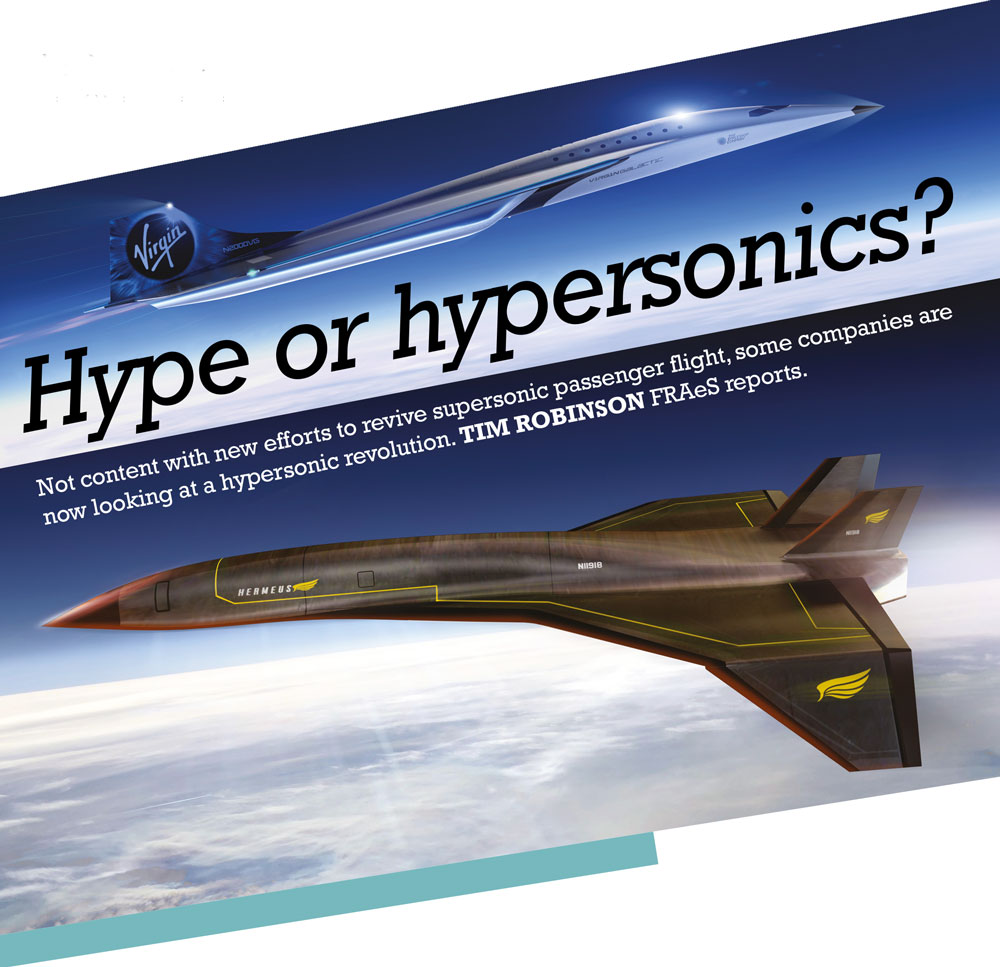 Above upper: Virgin Galactic has unveiled designs for a Mach 3 airliner and signed a non-binding memorandum of understanding (MoU) with Rolls-Royce to collaborate in designing and developing engine propulsion technology for the high-speed commercial aircraft. Above lower: Hermeus is promising a Mach 5 executive transport.
Above upper: Virgin Galactic has unveiled designs for a Mach 3 airliner and signed a non-binding memorandum of understanding (MoU) with Rolls-Royce to collaborate in designing and developing engine propulsion technology for the high-speed commercial aircraft. Above lower: Hermeus is promising a Mach 5 executive transport.
Some 18 years after Concorde touched down, dreams of high-speed air travel are now back in fashion with several projects to bring supersonic, and even hypersonic flight to tomorrow’s airline passengers. These plans have even received a form of high-level interest from none other than US President Joe Biden, who referenced the idea of supersonic airliners in a speech in 2021 on transport infrastructure.
Meanwhile, in the summer of 2021, US supersonic start-up Boom Technology received a major boost for its vision of future SST airliners when United Airlines signed an agreement to purchase 15 Mach 1.7 Overture airliners, with options for a further 35. Is high-speed passenger flight now set to return?
Enter Venus Aerospace
The latest player to arrive on an increasingly crowded pitch is Venus Aerospace, a small start-up founded by a husband and wife team of ex-Virgin Orbit executives, Andrew and Sarah Duggleby. Their concept is for a small 12-passenger Mach 12 vehicle which will fly at the edge of space. “We’re basically recreating the last leg of the space shuttle”, says Andrew Duggleby.
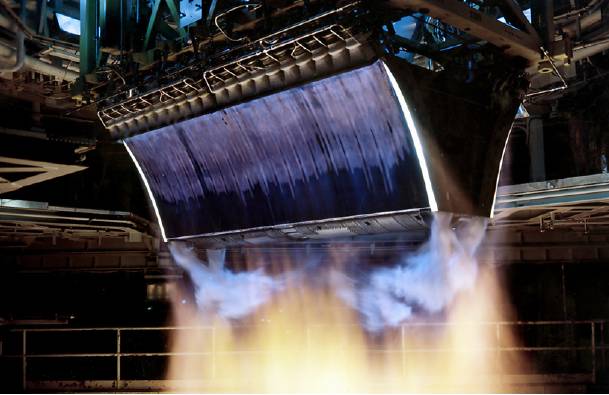 NASA’s linear aerospike engine was intended to power the X-33 Venturestar spaceplane. NASA
NASA’s linear aerospike engine was intended to power the X-33 Venturestar spaceplane. NASA
Flying at 150,000ft, the aircraft/spaceplane would be able to fly from LA to Tokyo in an hour, compared to the usual 11 hours. Venus’ concept would see the aircraft take off using a standard jet engine before engaging a rocket motor at around 50-60,000ft for around 15-20min, giving it boost-glide profile. On descent, the aircraft would slow and engage its jet engines again to land like a normal airliner. Despite this exotic propulsion and flight profile, Venus says that it is aiming for almost airliner-style turnaround times of around two hours and a ticket price equivalent to a current first class air ticket.
As well as high-speed passenger travel, the company also sees emerging applications for hypersonics in VVIP corporate and government travel, military roles where small teams need to be deployed against tight deadlines and ‘hyperlogistics’ – where small packages of critical goods (for instance, vaccines, aircraft parts or even vital fishing boat parts to Guam) need to be delivered urgently and time is money or lives.
For the love of speed
Some might raise eyebrows at this ambitious plan from a start-up, comprising eight people aiming to succeed where established aerospace concerns had failed but Venus points to a convergence in three areas of technology that now mean that the time is right – in advanced propulsion, vehicle shaping and cooling. Says Andrew Duggleby: “Anybody that looks at this is going to be, like, ‘There’s no way it works.’ And you’re right, there’s no way this works if these three things haven’t changed. So, there’s a change in propulsion technology on the combustion side, change in the vehicle aerodynamics and then a change on the leading edge cooling. Those three things really finally put this thing together and make it work.”
For the rocket, Venus is tight-lipped on the specifics but admits that it is ‘related’ to the linear aerospike engine – a type of rocket engine nozzle without a bell that maintains efficiencies at all altitudes. “It’s related. The reason that didn’t work is the same as what we’re doing. So it’s related but it’s not the same,” says Andrew Duggleby. The company also says that this innovative rocket would use 3D printing and advanced cooling technology. For fuel, Venus says that it would be ‘carbon-free’ on the rocket side.
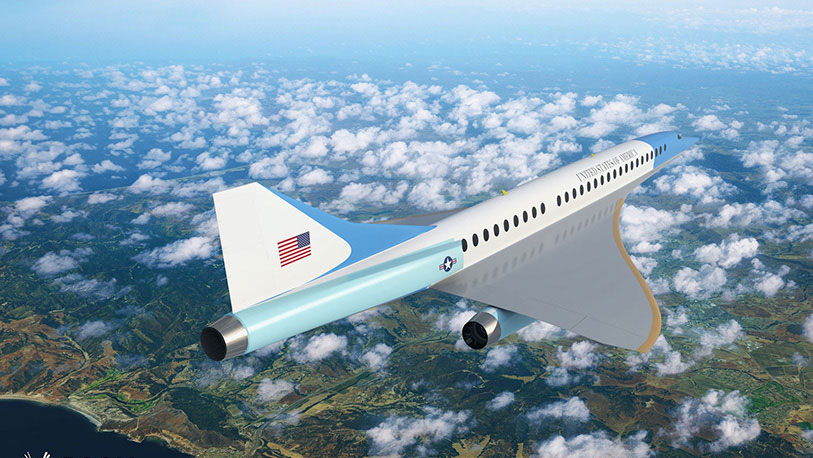 A Boom hypersonic concept imagined as Air Force One but will interest from the USAF for VIP transport missions help bring Boom’s Mach 2.2 Overture airliner to market? Boom Technology
A Boom hypersonic concept imagined as Air Force One but will interest from the USAF for VIP transport missions help bring Boom’s Mach 2.2 Overture airliner to market? Boom Technology
A Boom hypersonic concept imagined as Air Force One but will interest from the USAF for VIP transport missions help bring Boom’s Mach 2.2 Overture airliner to market? Boom Technology
Venus believes it has a breakthrough in a new, more stable aerodynamic shape for Mach 12 flight. A fan-art concept, approved by the company but one of several designs under consideration, shows a distinctive wedge-shaped vehicle with trapezoid anhedral wings rather than the cone or lifting body shape seen in other hypersonic vehicles. Venus stresses that this ‘fan-art’ is not to be taken as the final configuration but says that it is representative of ideas being mulled over and is ‘going in the right direction’. “There’s been a couple of advances in the world of hypersonics in terms of different vehicles shapes and what different configurations get you,” says Andrew Duggleby. “So we’ve actually come up with a way to make some of these configurations stable that were not stable beforehand.”
Finally, says Venus, the leading edges would use an innovative and unique leading edge active cooling concept to survive the white-hot temperatures of flight at Mach 15, using metallics and 3D printing, rather than ceramics or thermal tiles. Venus notes that, at the vehicle’s cruise altitude of 150,000ft, the thermal load is less than Mach 5 aircraft lower down where the atmosphere is thicker. This metallic leading edge and active cooling, says Venus, is the key to the quick turnarounds and the operating concept of four flights a day.
DESPITE THIS EXOTIC PROPULSION AND FLIGHT PROFILE, VENUS SAYS THAT IT IS AIMING FOR ALMOST AIRLINER-STYLE TURNAROUND TIMES OF AROUND TWO HOURS AND A TICKET PRICE EQUIVALENT TO A CURRENT FIRST-CLASS AIR TICKET.
Despite having secured an initial investment of $3m in seed funding, Venus is under no illusions that this is the beginning of a long and challenging road but says that it is aiming for around seven years before this aircraft could take to the skies. Development may inevitably require a sub-scale hypersonic demonstrator as well.
However, Venus says that, along with the development of a Mach 12 passenger aircraft, there will be incremental revenue streams along the way in hypersonic weapons, missiles or in ‘hyperlogistics’ drones. “As we go down our development path, looking into drones and smaller versions, our ultimate dream is the spaceplane but we know there’s a lot of opportunities as we go along with the technology for some offshoot technologies,” says Sarah Duggleby.
Venus is confident that the market exists for high-flyers wanting to ‘get home for dinner’, noting that there were 2,400 first class passengers flying from the West Coast of the US to Asia before the pandemic hit. Says Sarah Duggleby: “You know that there’s somebody who’s going to spend the same amount or equal to get there in an hour, as opposed to getting there in 13 hours. There’s enough of a market size that to get overseas in an hour changes the game completely.”
Venus is open-eyed about the challenges ahead for this small start-up with big plans. Andrew Duggleby: “The biggest challenges of anything this scale are threefold. One is good programme management. Get the technology working; that is the obvious one. The second one is a risk management from the programmatic point. The third piece is absolutely recognise the engagement with all parties, whether it be the FAA or the Japanese equivalent or the local airports. All of those engagements, certifications and standards become very key. Those are the three pieces that have to work right, in addition to keeping it funded.”
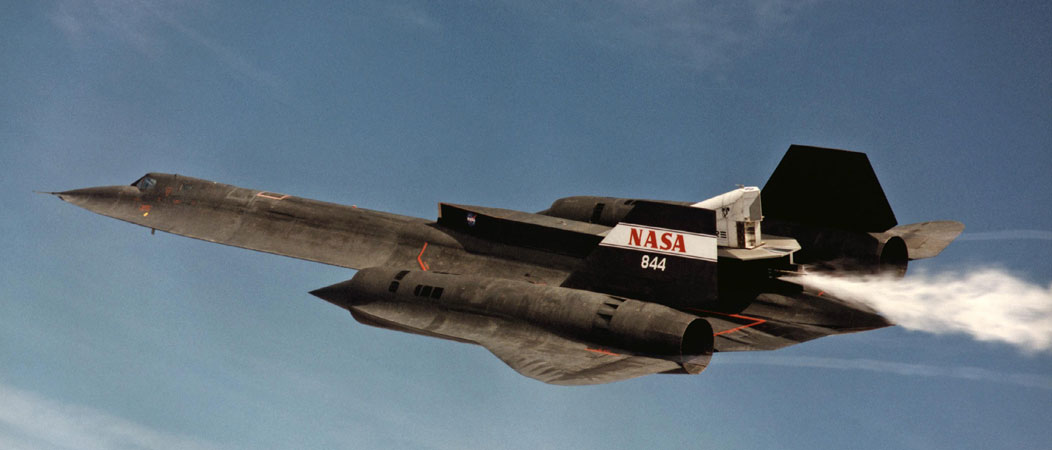 NASA conducted flight tests of a linear aerospike engine using a Lockheed Martin SR-71 in the late 1990s. NASA
NASA conducted flight tests of a linear aerospike engine using a Lockheed Martin SR-71 in the late 1990s. NASA
Accelerating momentum
Notably, it is not just a case of technology catching up with ambitions and making SST and HSTs more feasible but also there is an increased risk appetite for innovation and breakthroughs in aerospace, whether they be in green hydrogen propulsion or eVTOLs, that is helping to drive ideas that, only a few years ago, would have seemed like science fiction. SpaceX, for example, has been a touchstone for achieving what many assumed was impossible – so much so that its Falcon 9 vertical rocket landings have now become almost routine. Billions are now being pumped into the embryonic eVTOL sector by investors, despite any urban electric air mobility service flying a single paying passenger.
Momentum is building in the US to revisit and take the lead in supersonic civil flight – with NASA’s X-59 QueSST prototype set to fly in 2022 and trial low-boom technologies for overland flight. The FAA, too, is easing the way to approval of overland supersonic flights and airport operations – a turnabout from the 1970s when it was US-led opposition to Concorde’s sonic booms over populated areas that helped undermine the business case for the Anglo-French airliner. Boom, meanwhile, in 2020 rolled out its Baby Boom XB-1 sub-scale demonstrator, which is set to fly in 2022.
Yet, not all projects are destined to succeed. Florida-based Aerion, which has been working on a Mach 1.4 supersonic bizjet since 2004, with partners, such as Airbus, Lockheed Martin and Boeing, went bust in May 2021, despite having a $10bn orderbook for its AS2 bizjet and almost immediately after it had announced even more ambitious plans for a Mach 4 passenger airliner in seemingly a last roll of the dice to attract capital.
NASA conducted flight tests of a linear aerospike engine using a Lockheed Martin SR-71 in the late 1990s
Meanwhile, hypersonic weapons, in terms of missiles, are also now on the cusp of entering service with the US and are already in service in China and Russia. These bring speed of response and an unpredictable flight path to defeat air defences.
With these above drivers, it is thus no surprise that, as well as companies targeting the supersonic bizjet sector (Virgin Galactic, Spike Aerospace and UAC), passenger airliners (Boom and Exosonic) and even hypersonics (Hermeus and Venus Aerospace), there is now official government interest in high-speed transports for government VIP and special purposes. Indeed, the US Air Force’s Presidential and Executive Airlift Directorate recently placed several seed funding contracts with Exosonic, Hermeus and Boom to explore the potential of these transports for the potential of VVIP government transports.
As well as the time savings that a supersonic (or potentially hypersonic) aircraft which could whisk a future US President to meetings across the world, there are also the ‘optics’ of arriving in a sleek SST. Stepping off a needle-nosed aircraft also no doubt would boost US prestige – Nixon was heard to lament that he ‘wished that we had built it’ when shown the Concorde. Image too is a big selling point in the ultra-rarefied world of high-end business jets. For instance, there is an apocryphal story that thrust-reversers became highly fashionable in the 1980s on bizjets, not because of the reduced landing distances but because their distinctive noise when engaged told everyone nearby that a ‘VIP’ had arrived.
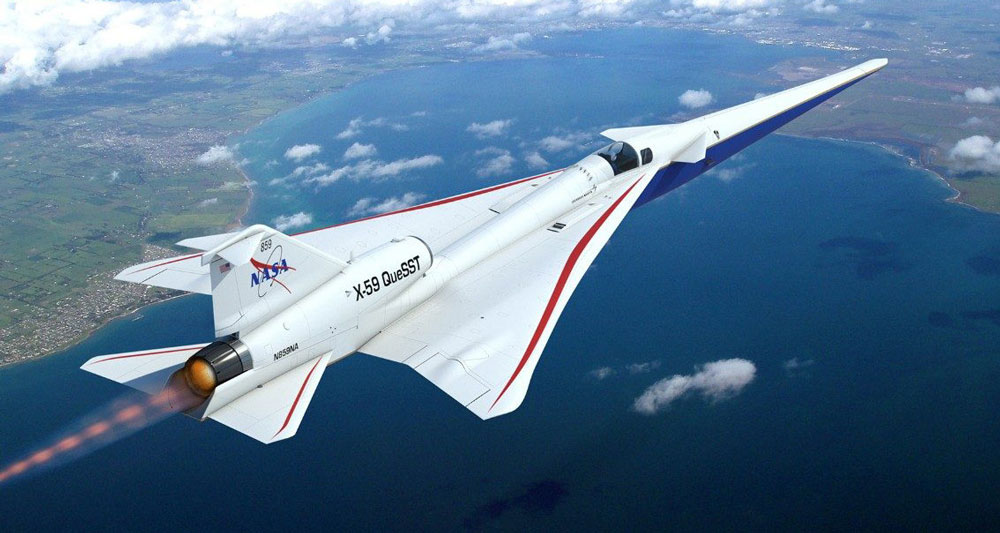 NASA’s X-59 QueSST X-plane, built by Lockheed Martin, is set to fly this year. Lockheed Martin
NASA’s X-59 QueSST X-plane, built by Lockheed Martin, is set to fly this year. Lockheed Martin
Engine options
As well as airframers, there are also a growing number of engine and propulsion specialists now eyeing up these high-speed passenger initiatives and their military applications. NASA has awarded GE a contract to study high-Mach propulsion as part of a hypersonic technology initiative. For the USAF, both Aero Rocketdyne and Northrop Grumman have demonstrated scramjet (supersonic ramjets) for high-speed designs. Pratt & Whitney, the manufacturer of the J58 that powered the Mach 3 SR-71, has also gone public that it is using that knowledge in a new hypersonic engine called the Metacomet.
HYPERSONIC WEAPONS, IN TERMS OF MANOEUVERING MISSILES, ARE ALSO NOW ON THE CUSP OF ENTERING SERVICE
Hermeus, one of the airframers working on a Mach 5 transport, is keeping its engine technology in-house and has already ground tested a Mach 5 powerplant in February 2020 and in 2021 publically displayed the engine working in afterburner on its sub-scale Quarterhorse prototype, which it aims to fly this year.
Meanwhile, in 2020, Boom Supersonic announced that it had signed an MoU with RollsRoyce for its planned 55-seat Overture Mach 2.2 airliner, joining Virgin Galactic which is also partnering with Rolls for the propulsion of a 19seat, Mach 3 bizjet.
The same year also saw Rolls-Royce deepen its strategic partnership with the UK’s Reaction Engines, which now gives it a unique entry point for potential partners wanting high-speed flight. With its air-breathing SABRE rocket engine, which has passed critical tests on the ground and been validated by external agencies, Reaction Engines is in the vanguard of powerplant developers, able to provide the types of engines suitable for Mach 4+ flight.
The company is already working with Rolls-Royce and BAE Systems on military applications for its SABRE pre-cooler technology with a EJ200 Eurofighter engine. Says Reaction Engines’ CEO Mark Thomas: “On high-speed flight we’ve got some very innovative concepts for new propulsion systems that enable high supersonic or hypersonic flights. We’re working on those with Rolls Royce, they’re a strategic partner of ours both in the UK and the US”.
Thomas outlines the opportunities for Reaction Engines from this wave of interest in supersonic and hypersonic travel: “We’re not making any pretence here that we want to be an airframer. So we’re either a propulsion provider to these multiple companies or we’re a fantastic partner. The relationship we have with Rolls Royce, which is part of a strategic partnership that we signed up to last year, means we have a much stronger footing now in the aero engine sector, both commercially and on a military basis.”
These efforts are not just limited to the US and the UK either, with Russia’s United Engines recently announcing it had tested a pulse detonation engine (PDE) with a 50% increase in specific thrust when compared to conventional jet engines. The PDE from A. Lyukli Design Bureau, says UAC, has applications for hypersonic aircraft and space launchers with the company saying it would also increase the range and payload of aircraft by 1.3-1.5 times.
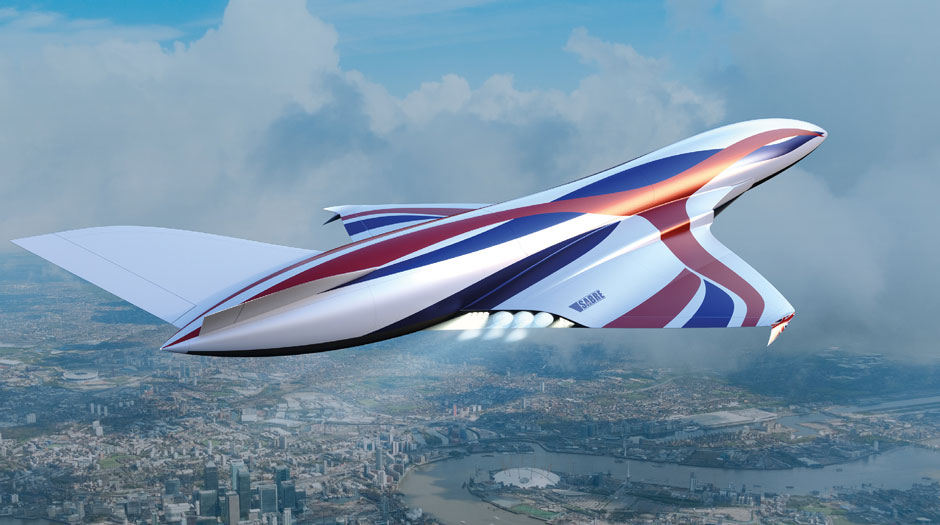 Reaction Engines
Reaction Engines
A supersonic bubble?
Despite this excitement, there must be caution in evaluating proposals and projects for supersonic and hypersonic passenger aircraft.
Firstly, there are the technological challenges – with hypersonics still being right at the bleeding edge of the possible. A recent test flight in 2021 with the USAF’s ARRW hypersonic missile was aborted due to a problem with the booster – a setback for what should be one of the most mature developments, given that the US is aiming to field it very shortly. This failure is just one of several failed test flights in the non-secret, non ‘black’ world of hypersonic flight test that we know of and shows how difficult this field is – even for testing small missiles.
Second is the immense cost that might be needed to bring these into service – not only for design, development and manufacturing but also for ongoing support and maintenance. Canada’s Bombardier, for example, found out the hard way how difficult it can be to break into the Airbus/ Boeing duopoly. Just re-engining a well known subsonic design, the Airbus A320, into the A320neo cost Airbus about $1.3bn. Testing and certification for such novel aircraft will add extra cost.
Thirdly, there is the regulatory challenge. While the FAA is moving to loosen the rules on overland, supersonic flight in the US, this will require global agreement and buy-in from other regulators. The fallout from the Boeing 737 MAX crisis also means that the FAA has arguably lost its position as an agency whose judgement is uncritically accepted by other regulators around the world. This could mean that supersonic/hypersonic transport operators may have extra work in convincing other aviation authorities around the globe to allow them to operate – especially in a world with tougher noise restrictions around airports. Will these class of aircraft require special exemptions to noise standards around airports?
Fourth is that, while jet lag and tiredness is still a factor, modern connectivity means there is less ‘dead time’ than in previous years; work can still be accomplished in flight and airlines have become highly skilled at pampering their first and business class passengers. The pandemic too has seen business shift to online and virtual meetings, which thus could eat into the expected market. While everyone wants to travel faster, hypersonic airliners may need the design of airports rethinking if the time savings in flight are undone by delays in the vaccine passport queues.
Fifth is that, since the heady days of Concorde, the world has changed significantly – with climate change, sustainability and now social inequality becoming more and more important. Even in 2001, Boeing found that its Sonic Cruiser was the wrong product for airlines – reinventing it into the 7E7 and then the 787, with an emphasis on fuel efficiency. Post-2008 financial crisis and with much of the world reeling from the pandemic and associated economic hardship, there is even more fury about the ‘privileged 1%’. Concorde, itself was estimated to contribute five times more in environmental impact than subsonic airliners, thanks to the high altitude at which its emissions were released. High-Mach flight will thus need to be sustainable and green – an extra challenge to bring into the technology itself. Manufacturers will thus need to consider these societal and environmental factors.
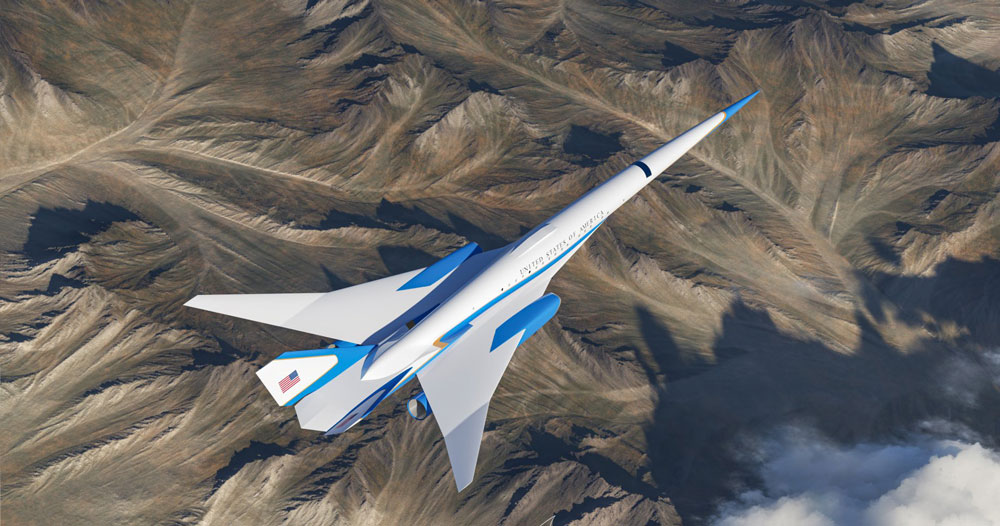 Exosonic’s supersonic Mach 1.8 airliner in a USAF VIP livery. Exosonic
Exosonic’s supersonic Mach 1.8 airliner in a USAF VIP livery. Exosonic
Summary
While defence requirements and emerging threats make a solid case for military hypersonic applications, whether they are sixth-generation fighters or missiles, the rationale for ultra-high-speed passenger flight is more nebulous and is even surprising insiders. “I do occasionally take a step back and say, with everything that’s going on in the world, pinch myself that we have so many companies looking at supersonic business jets. But time is precious and time is money and people do see the value of getting time back. If it can be done in a sustainable way, if you can do it with sustainable fuels, then there’s a lot to like about that sector,” says Reaction Engines’ Thomas.
While many would like to imagine that Concorde 2.0 supersonic and hypersonic passenger flight is not far off, some critics warn that the stagnation of development in conventional jet airliners is pushing investors to bet on high-risk, yet high pay-off, projects in the search for the next SpaceX ‘disruptor’. It is also notable that there is a growing divergence on the future of air travel developing across the Atlantic, with US proposals for high-speed flight being matched by European start-ups and developers revealing electric, hydrogen-powered green regional airliners.
What is true is that hypersonics are becoming ever more important in military planners’ minds. Civil applications then, may be a case of when, not if, the technology migrates to the commercial world – providing they can meet the challenge of sustainable high-speed flight.
 Above upper: Virgin Galactic has unveiled designs for a Mach 3 airliner and signed a non-binding memorandum of understanding (MoU) with Rolls-Royce to collaborate in designing and developing engine propulsion technology for the high-speed commercial aircraft. Above lower: Hermeus is promising a Mach 5 executive transport.
Above upper: Virgin Galactic has unveiled designs for a Mach 3 airliner and signed a non-binding memorandum of understanding (MoU) with Rolls-Royce to collaborate in designing and developing engine propulsion technology for the high-speed commercial aircraft. Above lower: Hermeus is promising a Mach 5 executive transport. NASA’s linear aerospike engine was intended to power the X-33 Venturestar spaceplane. NASA
NASA’s linear aerospike engine was intended to power the X-33 Venturestar spaceplane. NASA



